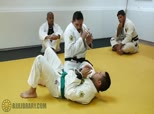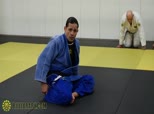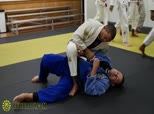Inside the University 937 - Keeping Your Elbows Attached to Your Body
Add to Favorites Remove From Favorites 503 1324 days ago
Now Saulo shows the importance of keeping your elbows tucked in and attached to your body when mounted. If your elbows are away, it's easy for your opponent to wrap them up for better leverage and attacks. He also stresses to move with your torso, not your arms.
Inside the University 936 - Blocking the Mount
Add to Favorites 520 Remove From Favorites 1325 days ago
Using the exact same movement as the solo drill, Saulo shows how to block the mount in a real situation. The key here is to react immediately when your opponent goes to take mount. If you wait until he has mounted you already, you are too late.Inside the University 935 - Solo Drill to Block the Mount
Add to Favorites 415 Remove From Favorites 1326 days ago
In this class Saulo focuses on not just escaping, but defending the mount. The key is to block the mount as soon as you feel your opponent going for it. A simple drill to practice is falling to your side, bringing your top hand across to the pocket, keeping your elbows tucked to your body. Make sure to breathe to help your mobility.Rafael Lovato Jr. Timeless 2-on-1 Attacks 9 - Controlling and Attacking from Mount
Add to Favorites 565 Remove From Favorites 1355 days ago
Answering another question, Rafael covers the basic things he looks for while in the mount, including his body positioning, using the violent hug and playing with different lapel chokes.Rafael Lovato Jr. Timeless 2-on-1 Attacks 8 - Hooking the Leg to Finish the Armbar
Add to Favorites 610 Remove From Favorites 1358 days ago
Now Rafael shows another option he sometimes uses to help finish the armbar if his opponent's grip on his lapel is really strong. He leans toward the leg and under hooks it to give himself leverage to keep inching his palm down his thigh until he can break the grip and secure the arm.Rafael Lovato Jr. Timeless 2-on-1 Attacks 7 - Finishing the Armbar when Opponent Grabs His Lapel
Add to Favorites 681 Remove From Favorites 1359 days ago
Rafael answers a student's question about finishing an armbar when your opponent is defending by grabbing his own lapel. He first threads his arm near the head through and cups his own thigh. He walks his hand down to his hip, and with his other hand he can push the lapel or the elbow to break the grip and secure the armbar.Dallas Niles Crucifix Series 7 - Transitioning to Mount when Opponent is Escaping
Add to Favorites 570 Remove From Favorites 1393 days ago
Now in an effort to escape the crucifix, Dallas' opponent drops his head to the floor and looks to roll back or spin around to side control. Right away Dallas looks to step his leg that is controlling the arm over to mount his opponent. Another option from here since the arm is inside is to look for the triangle.Xande Webinar 2 - Escaping the Mount
Add to Favorites 600 Remove From Favorites 1463 days ago
Answering a question on escaping the mount, Xande begins by showing a movement from Budokon Mobility, which is a forward sweep of his foot. After his initial hip escape to get on his side, he uses the foot sweep to position himself where he can lift his hips off the mat to get his guard back.Xande Webinar 2 - Escaping the Mount (Portuguese)
Add to Favorites 368 Remove From Favorites 1463 days ago
Answering a question on escaping the mount, Xande begins by showing a movement from Budokon Mobility, which is a forward sweep of his foot. After his initial hip escape to get on his side, he uses the foot sweep to position himself where he can lift his hips off the mat to get his guard back.Inside the University 900 - Bridge Mount Escape
Add to Favorites 462 Remove From Favorites 1518 days ago
To finish the class, Saulo goes over the most basic mount escape, the bridge or upa. Since it is fairly simple to shutdown the bridge escape, it is commonly used as a last resort when your opponent has his choking grips at your neck. This is the time you are more likely to roll him, as he will not be able to post with his hands at your neck.Inside the University 899 - Escape from Technical Mount
Add to Favorites 576 Remove From Favorites 1519 days ago
Often when you make your first defensive position while mounted, your opponent will switch to a technical mount. Saulo breaks down the necessary movement, and shows a mobility drill to practice in order to escape the technical mount.Inside the University 898 - Staying Calm and Timing Your Escape
Add to Favorites 587 Remove From Favorites 1521 days ago
Saulo discusses the importance of relaxing and staying calm when your opponent has you mounted. After he is able to bring his knee under his opponent's leg, then he is ready to explode to the other side and escape the mount.











